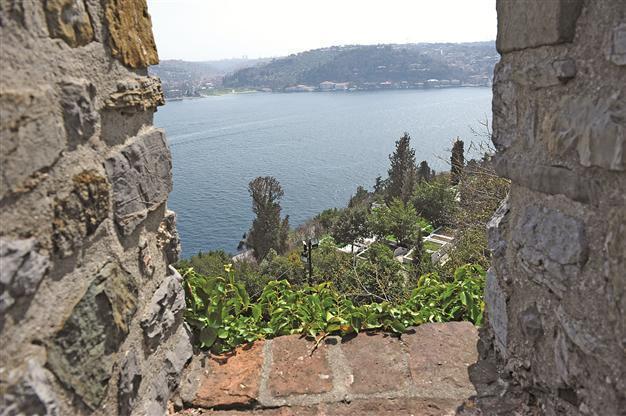Aşiyan, a dwelling in paradise
NIKI GAMM

Neslişah Sultan, the last member of the Ottoman dynasty was buried at the Aşiyan Cemetery with a marvelous view of the Bosphorus. The cemetery is located on a land between Bebek and Rumelihisarı. DAILY NEWS photos, Emrah GÜREL
The last member of the Ottoman dynasty, Neslişah Sultan, died this past week at the age of 91; she was buried next to her mother and sisters at Istanbul’s Aşiyan Cemetery. The dynasty is over but the family lives on. As Prime Minister Tayyip Erdoğan noted on news of her death, she carried the blood of Ertuğrul Gazi, Fatih Sultan Mehmed and Kanuni Sultan Süleyman in her veins. The Ottoman dynasty passed from father to son (or brother, uncle or nephew) for 623 years.Aşiyan Cemetery is one of the oldest cemeteries in Istanbul and enjoys a marvelous view of the Bosphorus from its location on the wooded slopes on the European side of Istanbul. This choice location has made it a much sought after burial ground, and many well-known people have been laid to rest there, from the 15th century – statesmen, politicians, writers, artists, and so on.
The Aşiyan Cemetery is on a one-kilometer stretch of land located between Bebek and Rumelihisarı. In pre-Turkish times, Bebek was reportedly the site of a pagan temple dedicated to Artemis. Whatever was on the land on which Rumelihisarı was built was destroyed when the fortress was built 560 years ago, although it was erected on the site of the ancient Phoneus. The 17th century travel writer Evliya Çelebi refers to the gardens located there and how the area belonged to the sultans. Sultan Selim I (r. 1512-1520) had a mansion there and Çelebi notes that its garden wasn’t much to speak of but its cypress trees were magnificent. Later Nevşehirli Damat İbrahim Paşa built the Humayunabad pavilion for Sultan Ahmed III (r. 1703-1730) during the Lale Devri or “Tulip” period. Bebek was particularly known for its fruits, such as apples, pears, plums, apricots and peaches.
Dervish tekke on the hill
Adjoining Bebek is the area known as Kayalar (stones), because of the rocky land here and this continues and includes the land on which the fortress was constructed. As one drives along the shore road, it’s impossible to miss the Kayalar Cemetery, although the area is usually referred to as the Aşiyan Asri Cemetery, because the gravestones start right at the edge of the road and are easily visible in spite of the area being heavily forested.
On the hill there used to be a dervish tekke or lodge belonging to the Bektashi order, which was the oldest such tekke in Istanbul. It was founded in 1452 at the same time that Fatih Sultan Mehmed built Rumelihisarı. Another story says that this tekke was next to the Kayalar Mescid on the shore. Obviously its history is somewhat unclear although the name of Durmuş Dede is associated with both. He was one of the successors of Hacı Bayram Veli and was considered the saint of sailors. He died in 1616, 1625 or possibly 1648 according to which source you want to believe. His tombstone can still be found along with the graves of other dervishes.
A story is told about others buried near Durmuş Dede and as sometimes happens, it could apply to one of two men, one known as Sheikh İsmail Çelebi and the other as İsmail Masuki Efendi. Both men and ten, or 12, of their disciples were executed in the Hippodrome. The first event occurred in the reign of Kanuni Sultan Süleyman I (r. 1520-66) and the second during Sultan Murat IV’s reign (1623-40). The reason for Masuki’s execution was that he claimed to be a part of Allah and preferred to die rather than retract his statement. Before he died, he asked that his and his disciples’ bodies be thrown into the sea at Ahırkapı and be buried wherever they came ashore. In spite of the current in the Bosphorus rushing to the south from the Black Sea, the bodies surfaced at Kandilli where the sultan and others saw them, speaking and performing their ritual dance. From there they were borne on the current across to the European side and Durmuş Dede’s tekke where they were buried.
Durmuş Dede who came from Anatolia was regarded as a saint. One day he told some boatmen in Üsküdar that he wanted to see the fortress being built but had no money. They refused him so he put a post that he had been carrying down on the water and miraculously stated sailing towards the castle. Fatih saw him and his miracle so he welcomed this guest. Later he had his soldiers build a new house for Durmuş Dede and so he got his name Durmuş (to stop) because the sultan commanded him to stop there.
From his death onwards until the dervish orders were closed by the Turkish government in 1925, sailors on their way to the Black Sea would stop and drop off food and wood for the dervishes in the tekke, or at least salute them as they passed, believing that it would bring good fortune to them on their voyage. The tekke was destroyed in 1936 to make way for the Bosphorus shore road.
Evocative atmosphere
In his book on the Bosphorus, John Freely quotes from H.S. Dwight who was writing in 1926 about the evocative atmosphere of Aşiyan Cemetery. “Another memento of that older time [referring to the Ottomans] is to be seen in the cemetery lying under the castle wall to the south. It is perhaps that oldest Mohammedan burying ground in Constantinople or at least on the European shore of the Bosphorus. It certainly is the most romantic, with its jutting rocks, its ragged black cypresses, its round tower and crenellated wall, overhanging a blue so fancifully cut by Asiatic hills. It has too, a spicy odor quite its own, an odor compounded of thyme, of resinous woods, of sea-salt and I know not what aroma of antiquity.”
A further attraction in the area is the house that poet and writer Tevfik Fikret had built at the top of the hill. Now a museum, it contains original furnishings and especially portraits by well-known artists and offers visitors a splendid view of the Bosphorus. It was known as Aşiyan, a Persian word meaning nest or house, and when combined with “cennet” it becomes a dwelling in Paradise - appropriate for its location.
















